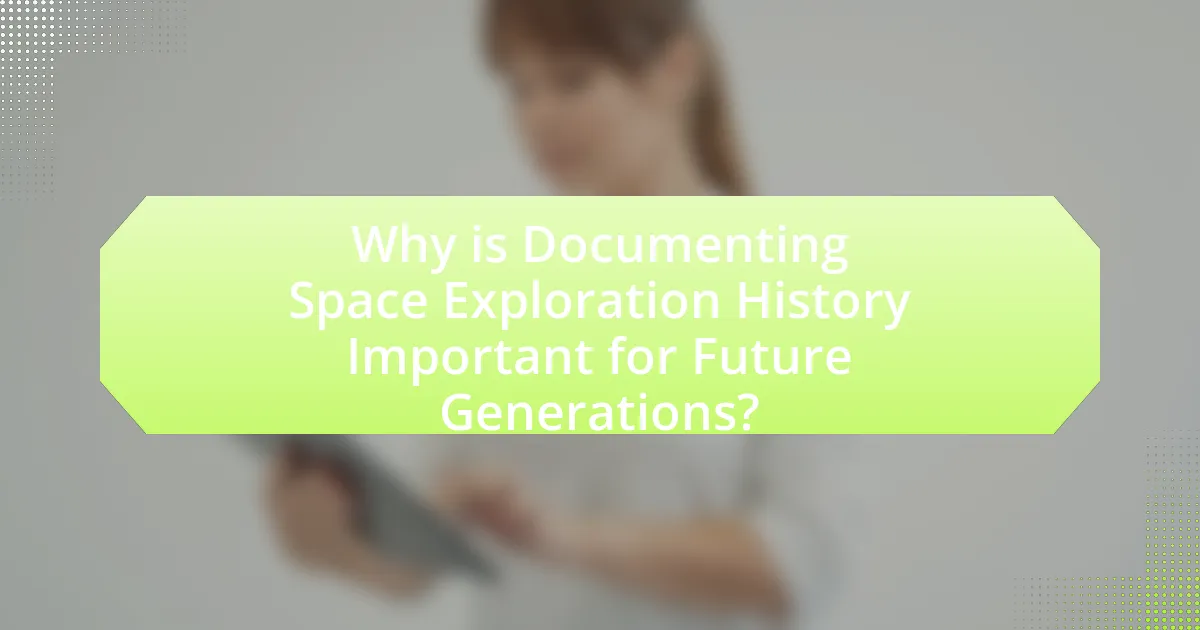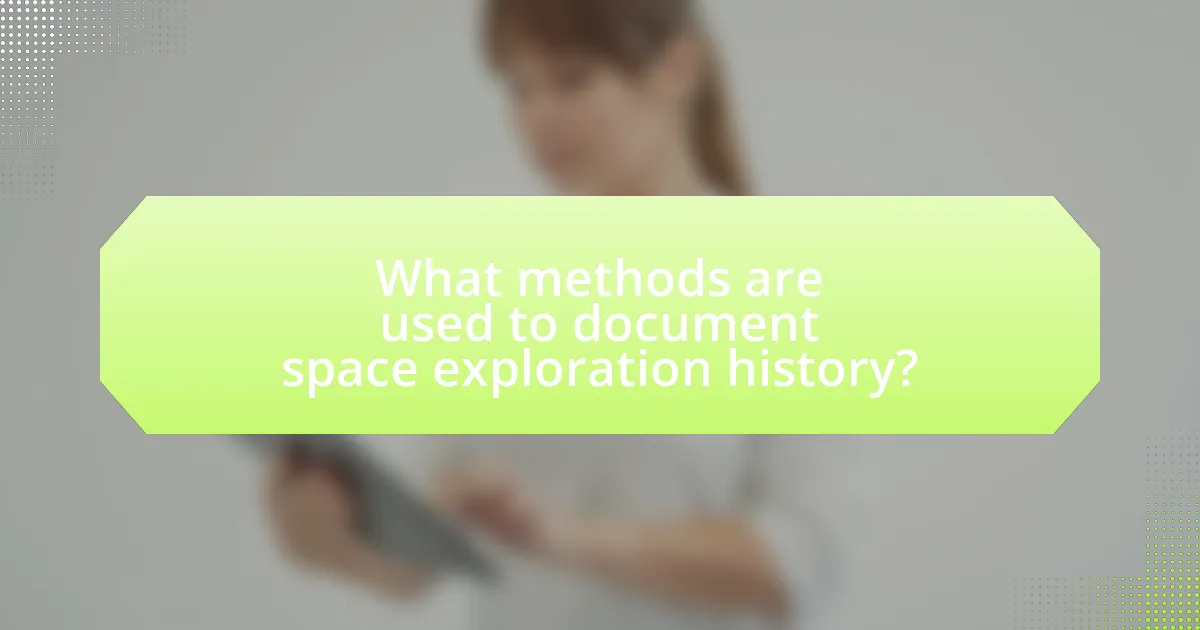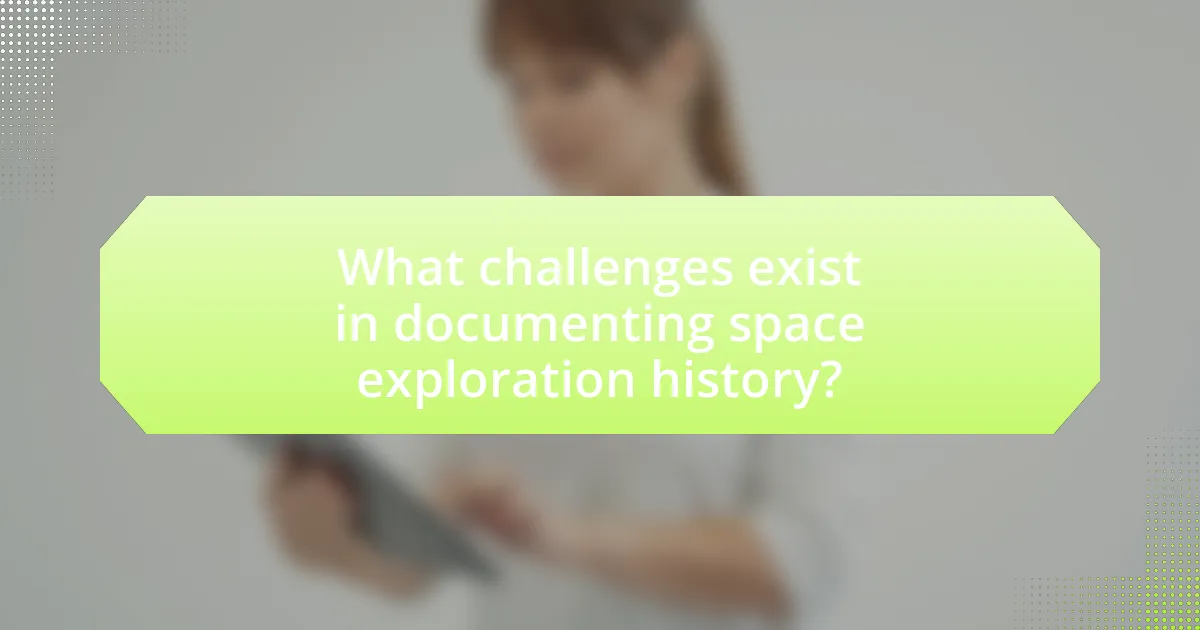Documenting space exploration history is essential for preserving knowledge, inspiring innovation, and guiding future policy decisions. This article examines the significance of historical records from missions like the Apollo program and the International Space Station, highlighting how they inform current and future space endeavors. It discusses the lessons learned from past efforts, the methods used for documentation, and the challenges faced in preserving this history. Additionally, the role of various organizations, media, and public engagement in enhancing documentation efforts is explored, emphasizing the importance of a comprehensive historical account for future generations of explorers and scientists.

Why is Documenting Space Exploration History Important for Future Generations?
Documenting space exploration history is crucial for future generations because it preserves knowledge, inspires innovation, and informs policy decisions. Historical records of missions, such as the Apollo moon landings, provide valuable insights into engineering challenges and solutions, fostering advancements in technology. For instance, the Apollo program led to developments in materials science and computer technology that are foundational to modern electronics. Furthermore, understanding past successes and failures in space exploration helps future policymakers make informed decisions about funding and international collaboration, as seen in the establishment of the International Space Station, which relies on lessons learned from earlier missions. This documentation serves as a roadmap for future exploration, ensuring that the achievements and mistakes of the past guide the next generation of explorers.
What lessons can we learn from past space exploration efforts?
Past space exploration efforts teach us the importance of meticulous planning and international collaboration. For instance, the Apollo program demonstrated that thorough preparation and testing are crucial for mission success, as seen in the successful Apollo 11 moon landing in 1969, which was the result of years of research and development. Additionally, the International Space Station (ISS) exemplifies how collaborative efforts among multiple countries can lead to significant advancements in science and technology, fostering a shared understanding of space. These historical examples highlight that learning from previous missions can enhance future exploration endeavors and ensure safety and efficiency in space travel.
How do historical missions inform current and future space endeavors?
Historical missions inform current and future space endeavors by providing critical insights into the successes and failures of past explorations, which guide decision-making and technological development. For instance, the Apollo program’s experience with lunar landings has shaped modern approaches to crewed missions, influencing safety protocols and mission planning for NASA’s Artemis program aimed at returning humans to the Moon. Additionally, the data collected from missions like Voyager, which has provided invaluable information about the outer planets, informs ongoing research and exploration strategies for future interplanetary missions. These historical precedents serve as a foundation for innovation, ensuring that lessons learned are integrated into new projects, thereby enhancing the likelihood of success in future space exploration initiatives.
What are the key milestones in space exploration history that should be documented?
The key milestones in space exploration history that should be documented include the launch of Sputnik 1 in 1957, which marked the beginning of the space age; the Apollo 11 mission in 1969, during which humans first landed on the Moon; the launch of the Space Shuttle program in 1981, which enabled reusable spacecraft; and the establishment of the International Space Station in 1998, which represents international collaboration in space. Each of these events significantly advanced human understanding of space and technology, shaping future exploration efforts.
How does documentation preserve the legacy of space exploration?
Documentation preserves the legacy of space exploration by systematically recording missions, discoveries, and technological advancements. This comprehensive record allows future generations to understand the challenges and achievements of past explorations, such as the Apollo moon landings, which are detailed in NASA’s extensive archives. These documents include mission reports, photographs, and scientific data, providing a factual basis for education and inspiration. Furthermore, the preservation of this information ensures that the lessons learned from successes and failures inform future endeavors in space exploration, as evidenced by the ongoing use of historical data in planning current missions like Artemis.
What role does storytelling play in documenting space history?
Storytelling plays a crucial role in documenting space history by transforming complex scientific achievements into relatable narratives that engage the public. This narrative approach helps to humanize the experiences of astronauts and scientists, making their contributions more accessible and memorable. For instance, the Apollo 11 mission is often recounted through the personal stories of Neil Armstrong and Buzz Aldrin, which not only highlights the technical milestones but also the emotional and psychological challenges faced during the mission. Such storytelling fosters a deeper understanding of space exploration’s significance and inspires future generations to pursue careers in science and technology.
How can documentation inspire future generations of explorers and scientists?
Documentation can inspire future generations of explorers and scientists by providing a comprehensive record of past discoveries, methodologies, and challenges faced during exploration. This historical context allows new explorers to learn from previous experiences, fostering innovation and informed decision-making. For instance, the meticulous documentation of the Apollo missions has not only preserved the technical achievements of lunar exploration but also serves as a motivational blueprint for current and future space endeavors, such as Mars exploration. By studying these records, future scientists can identify successful strategies and avoid past mistakes, ultimately driving progress in exploration and scientific inquiry.

What methods are used to document space exploration history?
Various methods are used to document space exploration history, including archival research, oral histories, and multimedia documentation. Archival research involves collecting and analyzing primary sources such as mission reports, photographs, and technical documents from space agencies like NASA and ESA. Oral histories capture firsthand accounts from astronauts, engineers, and scientists, providing personal insights into missions. Multimedia documentation encompasses films, documentaries, and digital archives that visually represent space missions and their impact. These methods collectively ensure a comprehensive and accessible record of space exploration for future generations.
How do various media contribute to the documentation of space exploration?
Various media contribute to the documentation of space exploration by providing diverse platforms for sharing information, visualizing data, and engaging the public. Television broadcasts, for instance, have historically showcased live launches and missions, such as the Apollo moon landings, allowing millions to witness significant events in real-time. Documentaries and films, like “The Last Man on the Moon,” offer in-depth narratives that explore the human experiences behind space missions, preserving personal stories and technical achievements. Additionally, social media platforms enable real-time updates and interactions, as seen during the Mars rover landings, where NASA shared images and insights directly with the public. Scientific journals publish peer-reviewed research that documents findings from space missions, ensuring that knowledge is rigorously vetted and accessible for future studies. Collectively, these media forms create a comprehensive archive of space exploration, ensuring that both the triumphs and challenges are recorded for future generations to learn from and inspire further exploration.
What types of records are essential for a comprehensive historical account?
Comprehensive historical accounts require various types of records, including official documents, personal diaries, photographs, and audiovisual materials. Official documents, such as mission reports and government publications, provide factual data and context about space exploration events. Personal diaries and letters offer insights into the experiences and thoughts of individuals involved, adding a human perspective to the historical narrative. Photographs capture visual evidence of missions and milestones, while audiovisual materials, including interviews and documentaries, preserve oral histories and interpretations of events. Collectively, these records create a multifaceted understanding of space exploration history, ensuring that future generations have access to a rich and accurate portrayal of past achievements.
How can technology enhance the documentation process?
Technology can enhance the documentation process by automating data collection and improving accessibility. Automation tools, such as data entry software and artificial intelligence, streamline the gathering of information, reducing human error and increasing efficiency. For instance, NASA utilizes advanced software to catalog and analyze vast amounts of data from space missions, ensuring accurate and comprehensive records. Additionally, digital platforms enable easy sharing and retrieval of documents, allowing researchers and the public to access historical data quickly. This accessibility fosters collaboration and knowledge dissemination, crucial for preserving space exploration history for future generations.
What organizations are involved in preserving space exploration history?
NASA, the National Aeronautics and Space Administration, plays a crucial role in preserving space exploration history through its extensive archives and documentation of missions. Additionally, organizations such as the Smithsonian National Air and Space Museum and the Space Foundation actively curate artifacts, exhibits, and educational programs that highlight significant achievements in space exploration. The American Institute of Aeronautics and Astronautics also contributes by promoting research and preserving the legacy of aerospace advancements. These organizations collectively ensure that the history of space exploration is documented and accessible for future generations.
How do governmental and non-governmental organizations collaborate in this effort?
Governmental and non-governmental organizations collaborate in documenting space exploration history through partnerships that leverage resources, expertise, and outreach capabilities. For instance, NASA often works with non-profit organizations like the Planetary Society to promote public engagement and education about space missions. This collaboration enhances the preservation of historical data and artifacts, as seen in joint initiatives to archive mission records and create educational materials. Additionally, funding from governmental bodies supports non-governmental projects aimed at documenting and disseminating space exploration narratives, ensuring a comprehensive approach to preserving this history for future generations.
What role do museums and educational institutions play in documenting space history?
Museums and educational institutions play a crucial role in documenting space history by preserving artifacts, conducting research, and providing educational programs. They collect and display significant items such as spacecraft, instruments, and documents that represent milestones in space exploration, thereby creating a tangible connection to historical events. For instance, the Smithsonian National Air and Space Museum houses the Apollo 11 command module, which serves as a physical representation of human achievement in space travel. Additionally, these institutions engage in scholarly research that contributes to the understanding of space history, often collaborating with scientists and historians to produce publications and exhibitions. Educational programs offered by museums and institutions, such as workshops and lectures, further disseminate knowledge about space exploration, ensuring that future generations appreciate and learn from past achievements.

What challenges exist in documenting space exploration history?
Documenting space exploration history faces several challenges, including the preservation of records, the accuracy of information, and the accessibility of data. Preservation issues arise due to the degradation of physical materials, such as film and paper, which can deteriorate over time, leading to potential loss of critical historical documents. Accuracy is challenged by the complexity of events and the potential for conflicting narratives, as different organizations and countries may present varying accounts of the same missions. Accessibility is hindered by the vast amount of data generated, which can be difficult to organize and retrieve, especially when considering the rapid evolution of technology and data formats. These challenges underscore the need for systematic approaches to archiving and documenting space exploration history to ensure that future generations have reliable access to this vital information.
What are the common obstacles faced in preserving historical records?
Common obstacles faced in preserving historical records include physical deterioration, inadequate funding, and lack of proper storage facilities. Physical deterioration occurs due to environmental factors such as humidity, temperature fluctuations, and exposure to light, which can damage documents and artifacts over time. Inadequate funding limits the resources available for preservation efforts, making it difficult to maintain and restore historical records. Additionally, many institutions lack proper storage facilities that meet the necessary standards for preserving sensitive materials, leading to further degradation. These challenges hinder the effective preservation of historical records, particularly in the context of documenting space exploration history, where unique artifacts and documents are crucial for future generations.
How can funding limitations impact the documentation of space history?
Funding limitations can significantly hinder the documentation of space history by restricting resources necessary for research, archiving, and preservation efforts. Without adequate financial support, institutions may struggle to maintain comprehensive records, leading to gaps in historical data and reduced accessibility for future generations. For instance, the National Archives and Records Administration has faced budget cuts that limit its ability to digitize and preserve important space-related documents, which can result in the loss of critical information about missions and discoveries. This lack of funding ultimately compromises the integrity and completeness of space history documentation, making it challenging for future scholars and enthusiasts to understand the full context of space exploration.
What issues arise from the rapid pace of technological advancement?
The rapid pace of technological advancement leads to several significant issues, including ethical dilemmas, job displacement, and security vulnerabilities. Ethical dilemmas arise as technologies like artificial intelligence and biotechnology challenge existing moral frameworks, necessitating new regulations and guidelines. Job displacement occurs as automation and advanced technologies replace traditional roles, with a World Economic Forum report predicting that 85 million jobs may be displaced by 2025 due to automation. Security vulnerabilities increase as interconnected systems become more prevalent, making them susceptible to cyberattacks, as evidenced by the rise in ransomware incidents, which increased by 150% in 2020 alone.
How can we overcome these challenges to ensure effective documentation?
To overcome challenges in ensuring effective documentation of space exploration history, implementing standardized documentation practices is essential. Standardization facilitates consistency and clarity, making it easier to compile and access information. For instance, organizations like NASA have established guidelines for documenting missions, which include specific formats and terminologies that enhance understanding across different teams and future researchers. Additionally, leveraging digital tools and platforms can streamline the documentation process, allowing for real-time updates and collaborative input. Research indicates that organizations that adopt digital documentation systems see a 30% increase in efficiency in information retrieval and sharing. By combining standardization with modern technology, effective documentation can be achieved, preserving vital historical data for future generations.
What best practices can be implemented for better documentation?
To achieve better documentation, implement structured formats, consistent terminology, and regular updates. Structured formats, such as templates, ensure uniformity and ease of understanding, while consistent terminology reduces ambiguity and enhances clarity. Regular updates are essential to maintain relevance and accuracy, as demonstrated by NASA’s practice of updating mission documentation to reflect new findings and technologies. This approach not only preserves historical context but also facilitates knowledge transfer to future generations, ensuring that the documentation remains a valuable resource.
How can public engagement and support enhance documentation efforts?
Public engagement and support can significantly enhance documentation efforts by increasing awareness, participation, and resources dedicated to preserving space exploration history. When the public is actively involved, it fosters a sense of ownership and responsibility towards documentation initiatives, leading to greater volunteerism and contributions of personal artifacts or stories. For instance, community-driven projects like the Apollo 11 50th Anniversary Celebration involved public contributions that enriched the historical narrative. Additionally, public support can attract funding and partnerships, as seen in initiatives like NASA’s Citizen Science projects, which leverage public expertise and enthusiasm to gather data and document findings. This collaborative approach not only broadens the scope of documentation but also ensures diverse perspectives are included, making the historical record more comprehensive and representative.
What practical steps can individuals take to contribute to documenting space exploration history?
Individuals can contribute to documenting space exploration history by engaging in research, writing, and sharing information through various platforms. They can start by collecting and organizing historical data, such as mission details, astronaut biographies, and technological advancements, which can be found in archives like NASA’s Historical Archives or the European Space Agency’s resources. Additionally, individuals can write articles, blogs, or books that highlight significant events and milestones in space exploration, thereby educating others and preserving knowledge. Participating in or organizing community events, such as lectures or exhibitions, can also raise awareness and encourage discussions about space history. Furthermore, contributing to online databases or platforms dedicated to space exploration, like the Space Exploration Archive, helps ensure that information is accessible for future generations.
